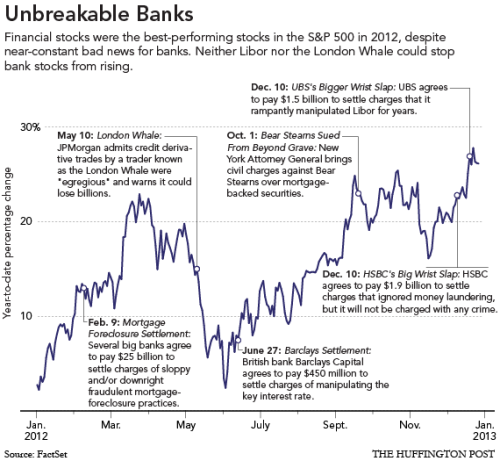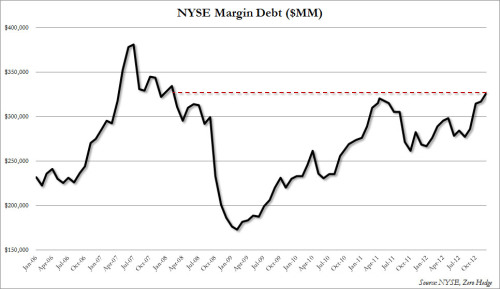There’s a much bigger cliff than the so-called fiscal cliff. The absolute worst result of the fiscal cliff would be a moderate uniform tax increase at a bad time, resulting in a moderate contraction. It is an obvious — but ultimately rather cosmetic — stumbling block on the so-called “road to recovery.”
The much bigger cliff stems from the fact that the so-called recovery itself is build on nothing but sand. This is a result of underlying systemic fragilities that have never been allowed to break. I have spent the last year and a half writing about this graph — the total debt in the economy as a proportion of the economy’s output:
This is the bubble that won’t go away. This is the zombified mess that the Federal Reserve won’t let dissolve (as happened regularly in the 19th century and early 20th centuries each time there was an unsustainable debt bubble). This is the shifting sand — preserved by the massive monetary stimulus programs — that the so-called recovery is built upon.
During the 1980s and 1990s and 2000s cheap money pumped up the debt level in America. In 2008, the bubble burst, and the hyper-connective fragile financial system was set to burn. Then central banks around the world stepped in to “stabilise” (or as Nassim Taleb puts it, overstabilise) the financial system. The unsustainable reality of debt vastly exceeding income was put on life support.
A high pre-existing residual debt level makes growth challenging, as consumers and producers remain focussed on paying down the pre-existing debt load, they are drained by pre-existing debt service costs, and they are wary about taking on debt or investing in a weak and depressed environment. It’s a classic Catch-22.
The only true panacea for the depression is growth, but the economy cannot grow because it is depressed and zombified. That’s where a crash comes in — the junk is liquidated, clearing the field for new growth. That is what Schumpeter meant when he talked of “the work of depressions”, something that many mainstream economists still fail to grasp. (In fairness, a similar effect can probably be achieved without a depression through a very large scale debt relief program.)
Japan has been stuck in a deleveraging trap for twenty years, to no avail, all that has really occurred is that the private debt load has been transferred onto the central bank balance sheet — there has been very little net deleveraging) and while the Japanese central bank has completed round after round of quantitative easing — sustaining and preserving the past malinvestment and high debt load — the Japanese economy is still depressed. 
That is the road America and most of the West are now on. And just as Japan’s bank stocks did multiple times even after the Japanese housing bubble burst, American banking stocks — even in spite of a year of fraud, abuse, mismanagement and uber-fragility — have been shooting up, up, up and away:
The zombie financial sector is the real cliff — as interconnective as ever, as corrupt as ever, and most importantly, nearly as leveraged as ever:
This is a reinflated bubble built on foundations of sand. I don’t know which straw will break the illusion (middle eastern war? Hostility between China and Japan? Chinese real estate and subprime meltdown? Student debt? Eurozone? Natural disasters? Who knows…) but this bubble poses a far greater threat in 2013 than the fiscal shenanigans and the Boehner-Obama “Boner-Droner” snoozefest.
- English (UK)
- English (India)
- English (Canada)
- English (Australia)
- English (South Africa)
- English (Philippines)
- English (Nigeria)
- Deutsch
- Español (España)
- Español (México)
- Français
- Italiano
- Nederlands
- Português (Portugal)
- Polski
- Português (Brasil)
- Русский
- Türkçe
- العربية
- Ελληνικά
- Svenska
- Suomi
- עברית
- 日本語
- 한국어
- 简体中文
- 繁體中文
- Bahasa Indonesia
- Bahasa Melayu
- ไทย
- Tiếng Việt
- हिंदी
The Real 2013 Cliff
Published 01/01/2013, 12:49 AM
Updated 07/09/2023, 06:31 AM
The Real 2013 Cliff
Latest comments
Loading next article…
Install Our App
Risk Disclosure: Trading in financial instruments and/or cryptocurrencies involves high risks including the risk of losing some, or all, of your investment amount, and may not be suitable for all investors. Prices of cryptocurrencies are extremely volatile and may be affected by external factors such as financial, regulatory or political events. Trading on margin increases the financial risks.
Before deciding to trade in financial instrument or cryptocurrencies you should be fully informed of the risks and costs associated with trading the financial markets, carefully consider your investment objectives, level of experience, and risk appetite, and seek professional advice where needed.
Fusion Media would like to remind you that the data contained in this website is not necessarily real-time nor accurate. The data and prices on the website are not necessarily provided by any market or exchange, but may be provided by market makers, and so prices may not be accurate and may differ from the actual price at any given market, meaning prices are indicative and not appropriate for trading purposes. Fusion Media and any provider of the data contained in this website will not accept liability for any loss or damage as a result of your trading, or your reliance on the information contained within this website.
It is prohibited to use, store, reproduce, display, modify, transmit or distribute the data contained in this website without the explicit prior written permission of Fusion Media and/or the data provider. All intellectual property rights are reserved by the providers and/or the exchange providing the data contained in this website.
Fusion Media may be compensated by the advertisers that appear on the website, based on your interaction with the advertisements or advertisers.
Before deciding to trade in financial instrument or cryptocurrencies you should be fully informed of the risks and costs associated with trading the financial markets, carefully consider your investment objectives, level of experience, and risk appetite, and seek professional advice where needed.
Fusion Media would like to remind you that the data contained in this website is not necessarily real-time nor accurate. The data and prices on the website are not necessarily provided by any market or exchange, but may be provided by market makers, and so prices may not be accurate and may differ from the actual price at any given market, meaning prices are indicative and not appropriate for trading purposes. Fusion Media and any provider of the data contained in this website will not accept liability for any loss or damage as a result of your trading, or your reliance on the information contained within this website.
It is prohibited to use, store, reproduce, display, modify, transmit or distribute the data contained in this website without the explicit prior written permission of Fusion Media and/or the data provider. All intellectual property rights are reserved by the providers and/or the exchange providing the data contained in this website.
Fusion Media may be compensated by the advertisers that appear on the website, based on your interaction with the advertisements or advertisers.
© 2007-2024 - Fusion Media Limited. All Rights Reserved.
